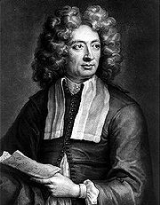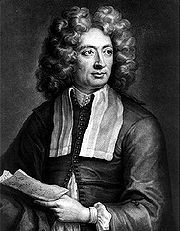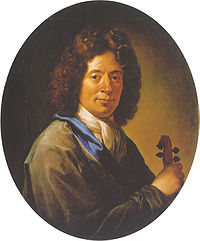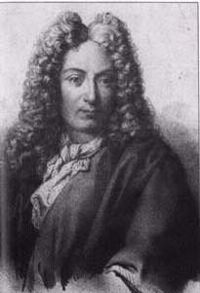
Arcangelo Corelli
Encyclopedia

Violin
The violin is a string instrument, usually with four strings tuned in perfect fifths. It is the smallest, highest-pitched member of the violin family of string instruments, which includes the viola and cello....
ist and composer
Composer
A composer is a person who creates music, either by musical notation or oral tradition, for interpretation and performance, or through direct manipulation of sonic material through electronic media...
of Baroque music
Baroque music
Baroque music describes a style of Western Classical music approximately extending from 1600 to 1760. This era follows the Renaissance and was followed in turn by the Classical era...
.
Biography
Corelli was born at FusignanoFusignano
Fusignano is a comune in the province of Ravenna in Italy. It is near Senio River is located near Fusignano where the Allied crossing occurred on April 9, 1945.-History:...
, in the current-day province of Ravenna
Ravenna
Ravenna is the capital city of the Province of Ravenna in the Emilia-Romagna region of Italy and the second largest comune in Italy by land area, although, at , it is little more than half the size of the largest comune, Rome...
, although at the time it was in the province of Ferrara. Little is known about his early life. His master on the violin was Giovanni Battista Bassani
Giovanni Battista Bassani
Giovanni Battista Bassani was an Italian composer, violinist, and organist.Battista was born in Padua. It is thought that he studied in Venice under Daniele Castrovillari and in Ferrara under Giovanni Legrenzi. Charles Burney and John Hawkins claimed he taught Arcangelo Corelli, but there is no...
, while Matteo Simonelli, the well-known singer of the pope's chapel, taught him composition.
He gained his first major success in Paris at the age of nineteen, and to this he owed his European reputation. From Paris, Corelli went to Germany. In 1681 he was in the service of the electoral prince of Bavaria; between 1680 and 1685 he spent a considerable time in the house of his friend and fellow violinist-composer Cristiano Farinelli
Cristiano Farinelli
Cristiano Farinelli was an Italian composer and violinist. Cristiano Farinelli was a friend of the composer Arcangelo Corelli and is said[Please name specific person or group] to have been the uncle of the castrato, Farinelli. Yet, this can prove to be false, because the singer Farinelli...
.

Pope Alexander VIII
Pope Alexander VIII , born Pietro Vito Ottoboni, was Pope from 1689 to 1691.-Early life:Pietro Ottoboni was born of a noble Venetian family, and was the son of Marco Ottoboni, chancellor of the Republic of Venice...
. From 1689 to 1690 he was in Modena
Modena
Modena is a city and comune on the south side of the Po Valley, in the Province of Modena in the Emilia-Romagna region of Italy....
; the Duke of Modena was generous to him. In 1708 he returned to Rome, living in the palace of Cardinal Ottoboni. His visit to Naples, at the invitation of the king, took place in the same year.
The style of execution introduced by Corelli and preserved by his pupils, such as Francesco Geminiani
Francesco Geminiani
thumb|230px|Francesco Geminiani.Francesco Saverio Geminiani was an Italian violinist, composer, and music theorist.-Biography:...
, Pietro Locatelli
Pietro Locatelli
Pietro Antonio Locatelli was an Italian composer and violinist.-Biography:Locatelli was born in Bergamo, Italy. A child prodigy on the violin, he was sent to study in Rome under the direction of Arcangelo Corelli...
, and many others, was of vital importance for the development of violin playing. It has been said that the paths of all of the famous violinist-composers of 18th-century Italy led to Arcangelo Corelli who was their "iconic point of reference".

George Frideric Handel
George Frideric Handel was a German-British Baroque composer, famous for his operas, oratorios, anthems and organ concertos. Handel was born in 1685, in a family indifferent to music...
's oratorio
Oratorio
An oratorio is a large musical composition including an orchestra, a choir, and soloists. Like an opera, an oratorio includes the use of a choir, soloists, an ensemble, various distinguishable characters, and arias...
The Triumph of Time and Truth
The Triumph of Time and Truth
The Triumph of Time and Truth is an oratorio by George Frideric Handel which saw three iterations across 50 years of Handel's career.HWV 46a is an Italian oratorio from 1707. In 1737 Handel revised and expanded the oratorio to create HWV 46b...
(premiered in Rome, 1708), and felt seriously offended when the composer (32 years his junior) played the note.
Nevertheless, his compositions for the instrument mark an epoch in the history of chamber music
Chamber music
Chamber music is a form of classical music, written for a small group of instruments which traditionally could be accommodated in a palace chamber. Most broadly, it includes any art music that is performed by a small number of performers with one performer to a part...
. His influence was not confined to his own country. Johann Sebastian Bach
Johann Sebastian Bach
Johann Sebastian Bach was a German composer, organist, harpsichordist, violist, and violinist whose sacred and secular works for choir, orchestra, and solo instruments drew together the strands of the Baroque period and brought it to its ultimate maturity...
studied the works of Corelli and based an organ fugue (BWV 579) on Corelli's Opus 3 of 1689.
Musical society in Rome also owed much to Corelli. He was received in the highest circles of the aristocracy, and for a long time presided at the celebrated Monday concerts in the palace of Cardinal Ottoboni.
Corelli died in possession of a fortune of 120,000 marks and a valuable collection of pictures, the only luxury in which he had indulged. He left both to his benefactor and friend, who generously made over the money to Corelli's relatives. Corelli is buried in the Pantheon at Rome
Pantheon, Rome
The Pantheon ,Rarely Pantheum. This appears in Pliny's Natural History in describing this edifice: Agrippae Pantheum decoravit Diogenes Atheniensis; in columnis templi eius Caryatides probantur inter pauca operum, sicut in fastigio posita signa, sed propter altitudinem loci minus celebrata.from ,...
. One can still trace back many generations of violinists from student to teacher to Corelli (the "Corelli school").
His compositions are distinguished by a beautiful flow of melody and by a mannerly treatment of the accompanying parts, which he is justly said to have liberated from the strict rules of counterpoint
Counterpoint
In music, counterpoint is the relationship between two or more voices that are independent in contour and rhythm and are harmonically interdependent . It has been most commonly identified in classical music, developing strongly during the Renaissance and in much of the common practice period,...
.
His concerti grossi have often been popular in Western culture. For example, a portion of the Christmas Concerto, Op. 6 No. 8, is in the soundtrack of the film Master and Commander: The Far Side of the World
Master and Commander: The Far Side of the World
Master and Commander: The Far Side of the World is a 2003 film directed by Peter Weir, starring Russell Crowe as Jack Aubrey, with Paul Bettany as Stephen Maturin and released by 20th Century Fox, Miramax Films and Universal Studios...
. He is also referred to frequently in the novel Captain Corelli's Mandolin
Captain Corelli's Mandolin
Captain Corelli's Mandolin, released simultaneously as Corelli's Mandolin. in the United States, is a 1994 novel written by Louis de Bernières which takes place on the island of Cephallonia during the Italian and German occupation of World War II. The main characters are Antonio Corelli, an...
.
Works
Corelli composed 48 trio sonataTrio sonata
The trio sonata is a musical form that was popular in the 17th and early 18th centuries.A trio sonata is written for two solo melodic instruments and basso continuo, making three parts in all, hence the name trio sonata...
s, 12 violin and continuo sonatas, and 12 concerti grossi.
Six opuses, published
Publications by Friedrich Chrysander
Karl Franz Friedrich Chrysander was a German music historian and critic, whose edition of the works of George Frideric Handel and authoritative writings on many other composers established him as a pioneer of 19th-century musicology....
between 1888 and 1891 by Chrysander
Friedrich Chrysander
Karl Franz Friedrich Chrysander was a German music historian and critic, whose edition of the works of George Frideric Handel and authoritative writings on many other composers established him as a pioneer of 19th-century musicology.Born at Lübtheen, in Mecklenburg-Schwerin, Chrysander was the son...
, are authentically ascribed to Corelli, together with a few other works.
- Opus 1: 12 sonate da chiesaSonata da chiesaSonata da chiesa is an instrumental composition dating from the Baroque period, generally consisting of four movements. More than one melody was often used, and the movements were ordered slow–fast–slow–fast with respect to tempo...
(trio sonatas for 2 violins and continuo) (Rome 1681) - Opus 2: 12 sonate da cameraSonata da cameraSonata da camera is literally translated to mean 'chamber sonata' and is used to describe a group of instrumental pieces set into three or four different movements, beginning with a prelude, or small sonata, acting as an introduction for the following movements.The term sonata da camera originated...
(trio sonatas for 2 violins and continuo) (Rome 1685) - Opus 3: 12 sonate da chiesa (trio sonatas for 2 violins and continuo) (Rome 1689)
- Opus 4: 12 sonate da camera (trio sonatas for 2 violins and continuo) (Rome 1694)
- Opus 5: 12 Suonati a violino e violoneVioloneThe term violone can refer to several distinct large, bowed musical instruments which belong to either the viol or violin family. The violone is sometimes a fretted instrument, and may have six, five, four, or even only three strings. The violone is also not always a contrabass instrument...
o cimbaloHarpsichordA harpsichord is a musical instrument played by means of a keyboard. It produces sound by plucking a string when a key is pressed.In the narrow sense, "harpsichord" designates only the large wing-shaped instruments in which the strings are perpendicular to the keyboard...
(6 sonate da chiesa and 6 sonate da camera for violin and continuo) (Rome 1700) The last sonata is a set of variationsVariation (music)In music, variation is a formal technique where material is repeated in an altered form. The changes may involve harmony, melody, counterpoint, rhythm, timbre, orchestration or any combination of these.-Variation form:...
on La FoliaFoliaLa Folia is one of the oldest remembered European musical themes, or primary material, generally melodic, of a composition, on record. The theme exists in two versions, referred to as early and late folias, the earlier being faster.-History:The epithet 'Folia' has several meanings in music...
. - Opus 6: 12 concerti grossi (8 concerti da chiesa and 4 concerti da camera for concertinoConcertino (group)A concertino is the smaller group of instruments in a concerto grosso. This is opposed to the ripieno which is the larger group contrasting with the concertino....
of 2 violins and celloCelloThe cello is a bowed string instrument with four strings tuned in perfect fifths. It is a member of the violin family of musical instruments, which also includes the violin, viola, and double bass. Old forms of the instrument in the Baroque era are baryton and viol .A person who plays a cello is...
, string ripienoRipienoRipieno or tutti can refer to:*the larger of the two ensembles in the concerto grosso. This is opposed to the concertino which are the soloists.*the notes added when realizing the figured bass of a basso continuo....
, and continuo) (AmsterdamAmsterdamAmsterdam is the largest city and the capital of the Netherlands. The current position of Amsterdam as capital city of the Kingdom of the Netherlands is governed by the constitution of August 24, 1815 and its successors. Amsterdam has a population of 783,364 within city limits, an urban population...
1714) - op. post.: Sinfonia in D minor, WoOWoOWoO is an acronym/abbreviation, derived from the German musical catalog phrase . WoO is a catalogue prepared in 1955 by Hans Halm and Georg Kinsky, listing all of the compositions of Ludwig van Beethoven that were not originally published with an opus number, or survived only as fragments.The...
1 - op. post.: Sonata a Quattro, WoO 2 (Rogers, Amsterdam, 1699 )
- op. post.: Sonata a Quattro, WoO 3 (Rogers, Amsterdam, 1699 – incomplete/dubious)
- op. post.: Sonata a Quattro for Trumpet, 2 Violins & B.C, WoO 4
- op. post.: 6 Sonate a tre, WoO 5–10 (Amsterdam 1714)
External links
- Arcangelo Corelli, profile at hoasm.org
- Adagio from Op. 5 played by Jennifer Bennett on baroque violin and Yair Avidor on theorbo
- Video of excerpts from the Corelli Christmas Concerto performed on original instruments by the ensembleMusical ensembleA musical ensemble is a group of people who perform instrumental or vocal music. In classical music, trios or quartets either blend the sounds of musical instrument families or group together instruments from the same instrument family, such as string ensembles or wind ensembles...
Voices of Music using baroque instruments, ornamentation and playing techniques.
Free sheet music
- Corelli, Arcangelo, scores for complete opp. 1–6, Center for Computer Assisted Research in the Humanities (CCARH) at Stanford UniversityStanford UniversityThe Leland Stanford Junior University, commonly referred to as Stanford University or Stanford, is a private research university on an campus located near Palo Alto, California. It is situated in the northwestern Santa Clara Valley on the San Francisco Peninsula, approximately northwest of San...

